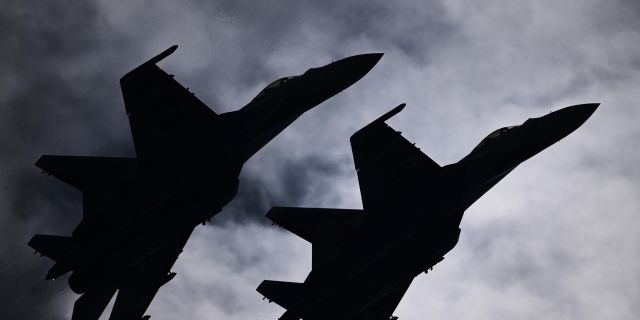TNI: The Russian Su-35 proved to be an effective opponent for the American F-35
The Russian Su-35 is considered one of the most advanced aviation systems of its generation, writes TNI. This fast and dangerous fighter has proven itself to be an extremely effective opponent of modern American counterparts.
The Su-35 (NATO classification: Flanker-E or “Flanker-E”) is considered one of the most advanced aviation systems of the “4++” generation and has incorporated many elements of the fifth generation.
The multi-purpose supermaneuverable single-seat fighter is designed to combat air and ground threats, as well as counter enemy surface forces.
In fact, the Su-35 is a deep modernization of the Su-27 (according to the NATO classification: Flanker) and was originally intended for export. However, since 2014, it began to enter service with the Russian Air Force, and in 2015 completed its first missions in Syria, where it was used to cover other Russian aircraft.
This “4++” generation fighter has proven to be an extremely effective opponent of modern American fighters, including the F-15 Eagle, F/A-18 Super Hornet and even the F-35 Lightning II. However, if the original Su-27 was developed in the 1970s to counter the American F-15 Eagle, then the Su-35 became the answer to the F-16.
Improved Su-27M
The development of the Su-35 began in the early 1980s, and the aircraft made its first flight in 1988, still under the name Su-27M. At that time, it was presented as a super-maneuverable Su—27 - primarily to gain air superiority, but also with significantly expanded strike capabilities.
The aircraft was intended to replace the Soviet Su-27 and MiG-29 fighters, and production of the Su-27M began in 1988. Subsequently, it was renamed the Su-35, however, according to the MilitaryToday website, only a dozen aircraft were built for the then Russian Air Force, including nine pre-production ones. In 1995, production ceased.
When it resumed, several improved versions immediately appeared, including the Su-35S. As of December 2022, the Kremlin had 110 such aircraft in its arsenal. They are in service with several fighter regiments of the Russian Aerospace Forces, including the 22nd Guards Fighter Aviation Regiment.
Currently, Su-35S fighters are manufactured at the aircraft factory in Komsomolsk-on-Amur (part of the United Aircraft Corporation as part of the Rostec state Corporation), and, according to Russian state media, the next batch was delivered in July.
Su-35 is a high—speed aircraft
Although the Su-27M /Su-35S has the same scheme with a smooth coupling of the wing to the fuselage, it can be distinguished from the basic Su-27 by destabilizers — horizontal surfaces in front of the wing. The large and powerful Saturn AL-41F1S engines provide the Su-35 with the ability to develop supersonic cruising speed for a long time — even without using an afterburner.
The engines are also equipped with a three-dimensional thrust vector, which gives the Su-35 high maneuverability. Currently, it is the only production fighter using nozzles with an axisymmetric deviation of the thrust vector.
The aircraft has a maximum take-off weight of 34.5 tons and can reach speeds of up to 2500 km/ h, a flight range of 1500-4500 km and a practical ceiling of 20,000 meters. In addition, he has super-maneuverability.
Not just a fighter to gain air superiority
Although the Su-35 is primarily designed to gain air superiority, it has additional capabilities for air combat and strikes against ground targets and can carry a huge amount of weapons. The fighter has 12 suspension units on the wing and fuselage, which allow it to carry ammunition with a maximum weight of up to 8000 kg, including air-to-air and air-to-ground missiles, anti-radar and anti-ship missiles, as well as a number of television, laser and satellite-guided bombs.
The Su-35's armament also includes a 30 mm GSH-30-1 automatic cannon with 150 rounds of ammunition.
In addition, the Su-35 can be equipped with an electronic warfare unit, which provides it with powerful jamming capabilities. It was reported that his electronic warfare equipment could reduce the effectiveness of enemy radars and “blind” the onboard radars of missiles, in particular the AIM-120 AMRAAM.
In addition, the fighter is equipped with a powerful radar control system, an optical-location system and an on-board self-defense system, and is also capable of controlling the actions of an aviation group in the air, as well as using the most modern guided aviation missiles.
According to the Airforce-Technology website, the pilot has two encrypted VHF/UHF radio communication systems and an interference-resistant military data transmission system between aircraft within the squadron, as well as between the aircraft and the ground control station. The navigation system uses a digital map display device with a free-form inertial navigation system and a global positioning system.
The export didn't go well
The aircraft was originally developed as an export model of the Su-27. A number of countries were mentioned as potential operators, including Algeria, Egypt, India and the United Arab Emirates. However, sales of the Su-35 to these countries have not taken place.
Meanwhile, in 2019, Russia completed the delivery of twenty-four Su-35 fighter jets to China as part of a deal with an estimated value of $ 2.5 billion. After Beijing became the first international customer of the Su-35, the United States imposed sanctions against China for violating the CAASTA law approved by Congress (on countering America's adversaries through sanctions). Despite this, the Su-35 officially entered service with the People's Liberation Army Air Force (PLA) in April 2018.
Peter Suchu is a writer from Michigan. During his twenty-year career as a journalist, he has collaborated with more than four dozen magazines, newspapers and websites, publishing over 3,200 articles. He regularly writes about military technology, the history of firearms, cybersecurity, politics and international relations. Also published in Forbes

